
|   |

|   |
What is Contemporary? - Sukanya Kumar e-mail: sukanya.kumar91@gmail.com February 4, 2021 One big advantage of the lockdown is the surge of digital media that facilitates participation by artistes from different corners of the globe on a common virtual platform. Redefining the contemporary is an on-going research project initiated by TomoeArts, a dance theatre company, based in Vancouver. The India round-table organized by TomoeArt was supported by ArtsComeOnline (ACO). ACO spearheaded by Shivani Jataris designed to provide space for artistes to express themselves through conversations and collaboration. The moderator was Kavya Iyer, dancer and researcher based in Paris."How is the contemporary expressed and perceived in dance form normally labeled as traditional or classical?" was the question posed to four artistes from different dance genres. "Dance is a reflection of society, everything we do in everyday life" said Kavya in her introductory speech. 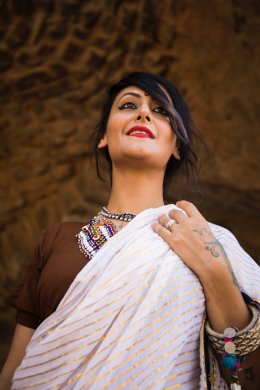 Meher Malik (Photo: Ozzie Sai) The first speaker, Meher Malik explained the origin of Belly dancing. It is the pagan birthing ritual of Rajasthan that was passed on from mother to daughter to prepare the womb for child-birth. This gypsy trail deeply connected to India landed up in different countries. Belly dance is perceived largely as entertainment for men and shunned as vulgar at times. Meher did feel "a tad bit out casted" and denied performance space in certain auditoria. Having studied different traditional styles, she has been working to make Belly dance more relevant to Indian cultural context. It is important to dissociate from the attributed identity of long hair, costume and show of midriff. A small snippet from her solo piece 'Body, Mind and Soul' demonstrated her moving away from these identities. "I shave off my long hair on stage," said Meher. The sensuous movements of the form, makes it threatening. "Belly dance is a very serious professional dance form," avers Meher. She considered Odissi very suitable for collaboration as the latter has fluid torso movements akin to Belly dancing. A video clipping of a project with Odissi dancer Nitisha Nanda, was shared, a project that had received harsh criticisms from one faction while many traditionalists appreciated the amalgamation. Meher concluded her session stating that dance is boundless and limitless; "It is a constant search for a language that doesn't seek words but direct entry into our heart." Kavya, the moderator, said that she was touched by the very human presentation by Meher. 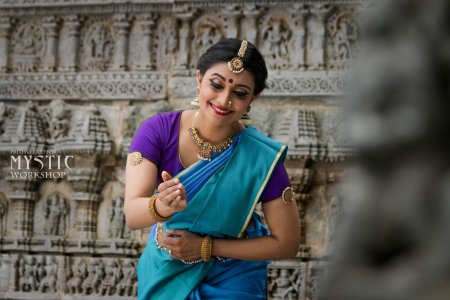 Divya Ravi (Photo: Prithvi Raju) Kavya applauded Divya Ravi, the second speaker for her amazing work on Instagram. At the outset, Divya Ravi said that her session would not necessarily be that of opinions and reflections, but questions. She mentioned the turbulent history of Bharatanatyam when it became a victim to Victorian standards of morality during the British era and almost fell into oblivion. "The art form was revived by the likes of Rukmini Devi, Balasaraswati and cine artistes like Kamala," she added. Besides the tangible legacies of the lyrical, musical and choreographic practice passed on in an untainted manner, the transmission of the intangible aspects like sadhana, heritage and discipline are also significant."Traditional art is exhaustive in construct and scope," said Divya. The kinetic vocabulary of Bharatanatyam is beautiful. We always talk of thinking out of the box. According to Divya, to do that, one needs to know what is inside the box. Many of her friends would hesitate to attend her traditional programs. Breaking the stereotype, Divya created a new margam 'Manjari- Mystique fragrances', which in a variation from the usual god as a protagonist, had a lotus flower in its place instead. An interesting trikala jati from this varnam was shared in the video clipping. The freedom offered by Bharatanatyam is mind blowing. It is easy to incorporate themes. "What isn't contemporary about emotions?" asks Divya. The video clipping about veganism using hasta mudra enhanced by nuanced narration by her husband Dr. Sharan Subramaniam was visually impactful. In another clipping 'Not just an idol' she questions the dichotomy that exists in our treatment of Goddess and woman. Divya opined that traditional, classical and contemporary are all subjective terms. It is important to respect artistic choices. Kavya reiterated Divya's question whether contemporary is a marker of relevant art created in the present. The third speaker was Hanne M.de Bruin, co-founder-director of Kattaikkuttu Sangam, Tamil Nadu. Hailing from Netherlands she has spent over three decades totally involved in the folk arts form. The opening video gave a glimpse of the colourful art form. She spoke of this full-fledged theatre style and the training method at the Gurukulam alongside education and comprehensive care. She informed that in keeping with the change in time women players are part of the koothu and play heroic characters. She cited an all-women presentation 'Rama-Ravana' and its contemporary approach by Rajagopal where he had juxtaposed Rama and Ravana, both played by women to show their power. Another twist in the last scene was given to the episode of disrobing of Draupadi. Challenged by Duryodhana, with her chastity at stake, she hits the dice on to his face. The Pandavas go to exile as free men and Draupadi emerges as a strong and bold woman. Women's issues were not so verbalized earlier. An unthinkable coming together of Carnatic music and Kattaikuttu - "two forms at outer ends on the same stage" - the last scene of Kurukshetra war, Rajagopal sings both higher and lower octaves and TM Krishna and Sangeetha Sivakumar sing in the lower octave; not an easy experiment! Koothu is an overnight continuous performance for nearly eight hours, without a written script. The economic aspect should be considered as funding is difficult to come by. Kavya agreed that we need to take into account the specificities of such art forms which we often tend to ignore. 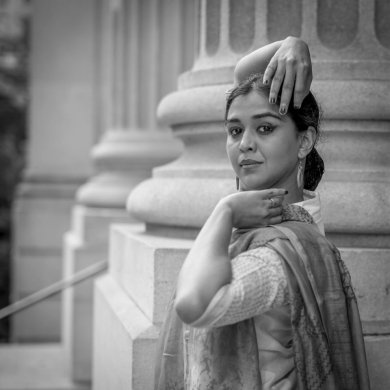 Sanjukta Wagh (Photo: Shreeram Aradhye) Sanjukta Wagh stated that Indian dance and theatre forms are complex and composite in nature. She quoted from TS Eliot to prove that tradition has a wide significance. "Tradition cannot be inherited. It must be obtained with great labour." Developing a sense of history in the now is indispensable. She said her art form is rooted in Kathak and Hindustani music and she believes in inculcating an inter-disciplinary approach among many art forms. She spoke of her project 'Rage and Beyond' as a contemporary retelling of Gandhari's character from Mahabharata. "I was irritated and annoyed with Gandhari. Who would like to lose a sense organ? I blind folded myself with a red cloth," informed Wagh. The project deployed five elements of words, silences, songs, tatkar and guitar strings and was developed over three years. The characters seen through the lens of modern feministic approach brought out "the rage" directed inwards. When she came across the poems of Shah Hussain, 16th century Sufi poet from Lahore, she was fascinated. It was a collective voice of defiant women."The space that it created did not allow a Kathak body to inhabit," said Wagh. There was a huge chasm between Sanjukta, the Kathak dancer and Sanjukta, the person. Her course in Laban helped her unlearn and teach her newly aligned body the needed movements. She ended with a question, "Is time to do away with binding terminologies like Traditional and Contemporary?" Kavya queried whether we should decolonize our thinking. Do we at all need these terms? 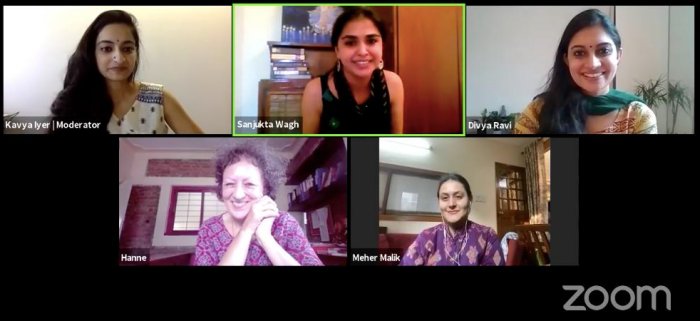 An interactive Q&A session followed. When asked what element of tradition would she retain in her contemporary choreography, Divya Ravi replied that it will be determined by what the theme demands. She would never consciously try to taint the art form. The end product would be aligned with the classical form. Meher narrated her association with Bollywood. How people react differently to Kathak and Belly dance even in Bollywood in spite of comparable time and effort spent by both. Audiences take what appears on big screen seriously. When people with preconceived notions watch Belly dance shows, they get educated and more aware. According to her, "contemporary" has defined techniques and development of vocabulary. What is termed as traditional today could have been contemporary 100 years ago. With all the limitations posed by the lockdown when the rest of the world was too stuck, art community has evolved showcasing revolutionary collaborative projects. As a teacher, Sanjukta trains students in Kathak parampara with focus on practice and non-negotiable values. She inculcates in them the Ganga Jamuna tehzeeb, the integral aspects of Kathak. Besides cherishing and caring for the punji we have inherited, it is essential to discover and co-create. She encourages her students to express themselves and adds their work to the 'Beej' repertoire. It is time for revision; it is time for the art world to become inclusive and less hierarchal. When asked whether it is time to redefine folk art category, Hanne replied that the Government should relook. The derogatory terms like rural, unsubstantial, non-elite, and undisciplined hinders the due recognition and growth. Covid has been terrible for them blocking live performances and income. "Exposure to each other's art form is important," concluded Hanne. 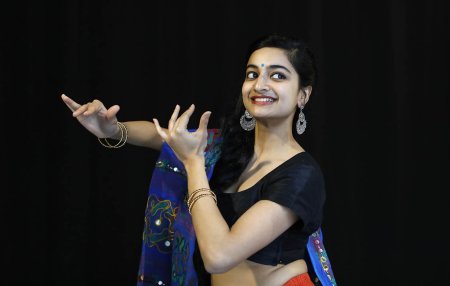 Kavya Iyer Kavya's comprehensive introduction and concise remarks knit the sessions well. She summed up that contemporary is not only about aesthetics and technique but also about social, political and economic issues. She congratulated Shivani Jatar for seamless technical coordination.  Sukanya Kumar is a practitioner of Bharatanatyam and Kathak genres trained under illustrious gurus. She is a Creative Culturist, and choreographer skilled in implementing electronic media technology in her productions to propagate social messages. She has a BSc in electronic media, MFA in Bharatanatyam, MBA in Educational management and MFA in Dance and Technology. |